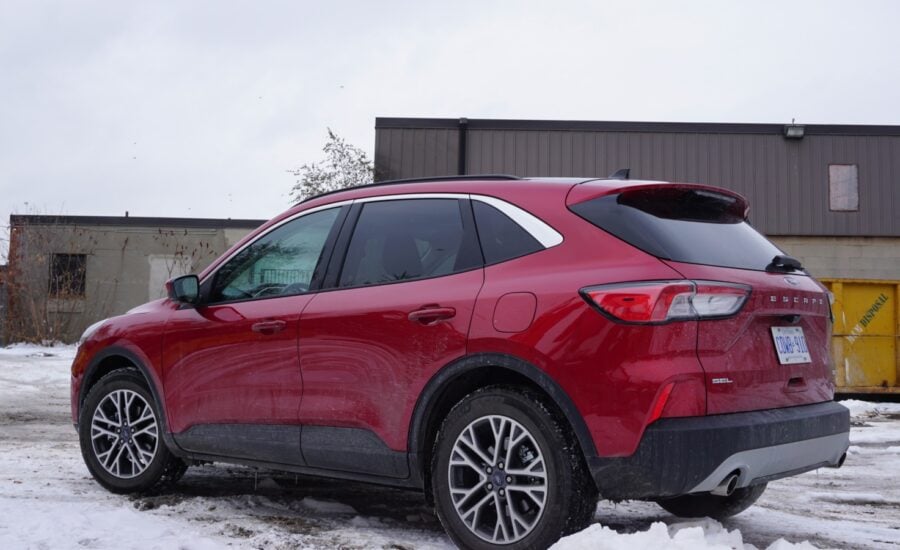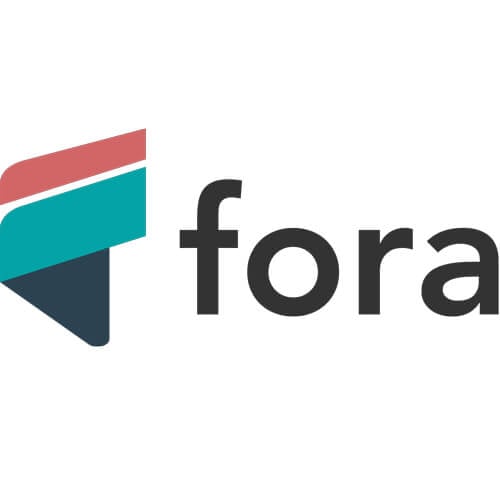Ford Escape review: The best used hybrid car
The Ford Escape entered its fourth and current generation in 2020—alongside a compelling hybrid-powered variant. Our review outlines its pros and cons.
Advertisement
The Ford Escape entered its fourth and current generation in 2020—alongside a compelling hybrid-powered variant. Our review outlines its pros and cons.

Reliability, style and fuel efficiency make the Ford Escape my pick for the best used hybrid car in Canada. This popular crossover utility vehicle (CUV), including its hybrid models, was all-new for model-year 2020, bringing an advanced new hybrid powertrain along for the ride. For fuel efficiency, feature content, and a refined and thrifty hybrid-powered drive, the fourth-generation Escape Hybrid deserves a spot on my list of the 10 best used cars in Canada.
In under 60 seconds, get matched with a personalized list of loan providers based on your needs and approval likelihood. No SIN required.
While most vehicles achieve the best fuel economy on the highway (and their worst fuel economy in stop-and-go driving), hybrids like the Ford Escape Hybrid turn that on its head. They’re especially appealing for drivers who do most of their driving in the city or in stop-and-go commuter traffic, where the Escape Hybrid’s engine actually achieves the best fuel efficiency. Put another way, hybrids like the Ford Escape Hybrid tend to get their best fuel economy in situations where non-hybrid models are the thirstiest.
When buying a used Ford Escape, you can find front or all-wheel drive (AWD), along with gas or gas hybrid engine options and an available plug-in hybrid (PHEV) that was introduced for model year 2020, despite production delays.
The original Ford Escape hit the market for the 2001 model year, with the first-generation Ford Escape Hybrid arriving in 2005 as the first hybrid SUV on the road. More recently, the latest generation of the Ford Escape hit the road in 2019 for the 2020 model year.
If you’re looking to upgrade from an earlier-generation Escape, you’ll find the 2020 and newer models to be a little more spacious and accommodating. They’re longer and wider (though lower) than their predecessors. For a more fully loaded experience, check out a used Escape with the new-for-2021 Bang & Olufsen stereo system upgrade.
The Escape Plug-In Hybrid runs Ford’s advanced fourth-generation propulsion system, including a 2.5-litre hybrid engine and electronic continuously variable transmission. Driving a Ford Escape Hybrid is easy: you just fill the tank with gasoline and drive it, like any other SUV. If you’ve got your eye on an Escape Plug-In Hybrid, that’s still true—though you can plug in to recharge this specific model whenever it’s convenient, to help save fuel. The Ford Escape Plug-in Hybrid has a plug, but the Ford Escape Hybrid does not. Remember: plugging in an Escape Plug-In Hybrid is never a requirement. As long as there’s gasoline in the tank, you’re ready to drive.
By the way, you’ll likely find this hybrid powertrain quieter, smoother and more refined than the one in a comparable Toyota RAV4.
For model-year 2021, Ford updated the Escape with new appearance packages and improved interior colour and materials selection, and speed sign recognition, a new safety feature. A Class II trailer hitch also became available on SE, SEL and titanium hybrid / plug-in hybrid models.
Yes, and if you’re familiar with the previous model, a short test drive in a 2020 or newer unit will likely convince you that Ford got serious about its latest Escape, partly thanks to rapidly improving competition. The latest Escape marked a huge leap ahead from the previous-generation car.
What’s new in the Ford Escape? Let’s start off with the styling. For 2020, designers created a body that’s vastly easier on the eyes than its predecessor. Sure, some of the design cues are derivative, and the front end is borrowed from Ford’s European sedan offerings, but overall, it’s a pleasing aesthetic.
Let’s look at the Escape from the inside out. In the past, even top-rung titanium trim had a hard time convincing people that the Escape’s interior was comfortable, refined and thoughtfully designed. The 2020 model leaves all that behind, with even the bottom-end SEL trim level proving a worthy challenge to comparable competitors.
If you’re upgrading from an earlier-generation Escape, you’ll likely notice the improvements right away. Engineers took great efforts to eliminate road and wind noise, and sounds from under the hood—engine noise, vibration and harshness—have been hushed. The feeling of tranquility never wanes, all the way up to and including highway speeds.
Ford paid attention to various surfaces and touch points, and the Escape offers a much friendlier environment to interact with. Additionally, Ford’s SYNC infotainment system has been given a slicker interface and is noticeably quicker to respond.
Anyone who found the older model a little small in the cargo area will be delighted by the commodious hold, and passenger room has been increased enough to make longer trips more comfortable.
Is this car durable? The Escape Hybrid is a vehicle of choice for taxi cabs in New York City, with many cab companies running fleets of these machines—a testament to how well they hold up after they’ve left the showroom floor.
The Ford Escape’s latest hybrid engine is a 2.5-litre four-cylinder gasoline unit (regular grade is fine), teamed up with two electric motors to generate 200 horsepower.
The electric motors are powered by a dedicated hybrid battery pack that recharges automatically while you drive around. Electricity stored within can be used to boost the power of the gas engine, or take over the work of driving the Escape fully in some situations, reducing fuel usage.
Though standard Escape Hybrid models have no plug to connect, the available Plug-in hybrid version does. Whenever it’s convenient, connecting to an external power source can store enough electricity for 60 kilometres of all-electric driving within the PHEV model’s larger battery. The Ford Escape PHEV not only offers conventional hybrid operation when it is using gasoline, it also allows for dozens of kilometres of all-electric driving every day of the year—enough to get many Canadians off of gasoline for their daily commutes.
The all-wheel drive works with no driver decision-making required, delivering the traction required for use in inclement weather and for tackling winter conditions common in much of Canada. Using a quality set of winter tires will dramatically improve the performance of the Escape’s AWD, braking and traction management systems in winter driving, allowing drivers to get the most out of the car’s weather-busting tech.
The Escape has made significant gains in interior quality, but there’s still room for improvement. Take the interior door panels as an example. It seems as though Ford could have exerted a bit more effort on fitting and finishing the door panel trim, but this certainly isn’t a hill to die on.
The rotary shifter allows console space for a purse or what have you, but it feels a bit shaky and imprecise. And the placement of the ignition button—in the dashboard, to the right of and behind the steering, at an angle rather than facing the driver—felt like an afterthought at first, but you do get used to it.
Open and close all of the doors multiple times, confirming that none fail to close with moderate force. Check all power windows for proper operation, too. If you note any trouble here, faulty spot welds may be to blame. According to a service message from Ford, some models from 2020 and 2021 may have a cracked or broken spot weld at the check arm attachment point in the door assembly, especially if the vehicle has been heavily used.
Be on the lookout for transmission fussiness, too. If the Escape you’re test-driving seems to hesitate or lag when shifting gears, or if throttle response is harsh or inconsistent, a software update may be required to optimize the transmission’s behaviour. Symptoms like these can be signs of more serious trouble with transmission internals, too—so if something feels off, be sure to have the vehicle checked professionally before you buy.
This generation Ford Escape was also subjected to at least 12 safety recalls in Canada, meaning the model you’re considering might need to visit its dealership for a repair or inspection to deal with a latent safety defect. Recall work is performed free of charge by dealers, and you can check to see which (if any) recalls apply for the Ford Escape you’re considering by plugging its VIN into Ford’s recalls webpage.
Check the spare tire in your used Ford Escape candidate, too. You’ll want to know what’s available in the event of a flat tire or blowout, and that all provisions are present and in good shape.
Air conditioner feel wimpy? Check the cabin air filter. A clogged or dirty cabin air filter can cause poor performance from the air conditioner and defroster and even damage the system (or your vehicle). This can cost you money and reduce your fuel economy, too.
If opting for a PHEV model, carefully check the charge port and any included charger cables and connectors for signs of damage, burning or melting. Though rare, using non-factory-approved parts to charge your PHEV can cause expensive damage that isn’t covered by warranty. If included charging provisions are damaged or badly worn, budget for a replacement. If there’s any damage to the vehicle’s built-in charging connector, have it checked by a professional before you buy.

Apply for a personal loan with a 8.99% to 29.49% APR. Plus, 100% online application and no early repayment fees.

Apply for a personal loan with a 9.99% to 35.00% APR. Plus, fast e-transfers and no hit to your credit score when you apply.

Apply for a personal loan with a 19.90% to 34.90% APR. Plus, fast funding (as soon as the same business day). Not available in Quebec, PEI, Manitoba, Newfoundland and Labrador, Northwest Territories, Nunavut and Yukon.
Ford’s efforts to refine and enhance the Escape in recent years give used SUV shoppers a compelling choice in a hotly contested segment.
Those upgrading from an older Ford Escape into the latest generation machine will find the interior finishes, road manners and powertrain to be significantly more refined and up-market.
First-time buyers can consider a used Ford Escape a solid entry into the SUV scene thanks to its easy-to-access dealer support, strong safety story, highly-competitive power and drive, and generous selection in the used marketplace.
Though the Ford Escape Hybrid strikes a compelling balance of price, efficiency, refinement and performance for your gas dollars, SUVs come in many shapes and sizes, and shoppers have plenty of options for hybrids in this popular segment.
The Hyundai Tucson and Toyota RAV4 are key competitors to the Ford Escape, and they also come with a range of hybrid and non-hybrid engines, including PHEV options.
For a larger option with a hybrid engine, check out the Mitsubishi Outlander PHEV or Toyota Highlander Hybrid.
The Chrysler Pacifica Hybrid is a minivan (not an SUV), but a PHEV engine and flexible, very spacious cabin make it a compelling alternative for some shoppers in search of maximum space and minimal fuel bills, too.
Auto insurance quotes are based on several factors, including your age, location and more. Here’s the estimated monthly cost to insure a 2020 Ford Escape Titanium Hybrid AWD for these driver profiles:
Quotes provided by Ratehub*. (Ratehub and MoneySense are both owned by Ratehub Inc.) Policies include $1 million liability coverage, $1,000 collision deductible and $1,000 comprehensive deductible, with discounts for bundling and UBI.
Affiliate (monetized) links can sometimes result in a payment to MoneySense (owned by Ratehub Inc.), which helps our website stay free to our users. If a link has an asterisk (*) or is labelled as “Featured,” it is an affiliate link. If a link is labelled as “Sponsored,” it is a paid placement, which may or may not have an affiliate link. Our editorial content will never be influenced by these links. We are committed to looking at all available products in the market. Where a product ranks in our article, and whether or not it’s included in the first place, is never driven by compensation. For more details, read our MoneySense Monetization policy.
Share this article Share on Facebook Share on Twitter Share on Linkedin Share on Reddit Share on Email